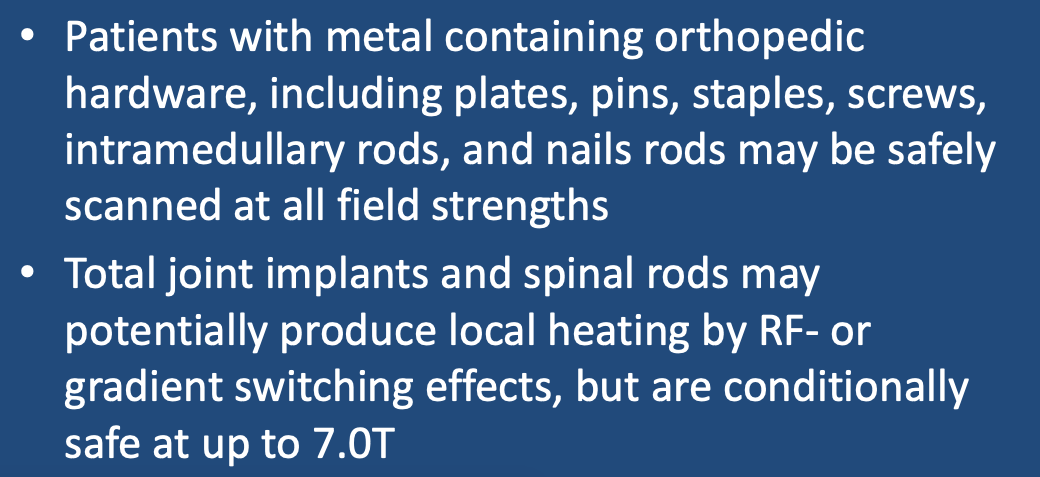 Titanium plate and screws
Titanium plate and screws
Nearly all orthopedic implants are made of three types of materials: metals, polymers, and/or ceramics. As polymers and ceramics are MR Safe, we need only concern ourselves with those containing metal. The primary metals used include surgical grade stainless steel (commonly 316L), cobalt-chromium (Co-Cr) alloys, pure commercial titanium (Ti), and titanium alloys (e.g., Ti-6Al-4V). All are these metals are either weakly ferromagnetic or non-ferromagnetic, and thus are MR Conditional but present no danger of displacement in the magnetic field provided they are secured to bone or another stable structure. They will create local susceptibility artifacts, however, with iron-containing alloys more so than titanium-containing ones. Susceptibility artifacts may even persist after removal of an implant due to the presence of tiny metallic fragments or dust.
A small number of ferromagnetic plates and screws implanted before the early 1990s may occasionally be encountered, such as the Perflex interference screw used for cruciate ligament reconstruction of the knee. Even though a rare patient might present with highly ferromagnetic legacy orthopedic hardware, no significant safety issues should be raised. As long as these implants are secured to bone they are not dangerous to the patient, although the localized artifacts produced will be substantial.
Very large orthopedic implants, such as spinal rods and total joint prostheses, may create localized tissue heating secondary to radio-frequency- or gradient-switching-induced currents, as described in this related Q&A. To my knowledge no deep thermal burns have been reported near such implants, but localized tissue temperature increases of several °C have been measured in phantoms and estimated numerically. So it may be wise to limit high-SAR or rapid gradient-switching sequences for such patients.
Advanced Discussion (show/hide)»
No supplementary material yet. Check back soon!
References
Arduino A, Zanovello U, Hand J, et al. Heating of hip joint implants in MRI: the combined effect of RF and switched-gradient fields. Magn Reson Med 2021; 85:3447-3462. [DOI LINK]
Bagheri MH, Hosseini MM, Emami MJ, Foroughi AA. Metallic artifact in MRI after removal of orthopedic implants. Eur J Radiol 2012; 81:584-590. [DOI LINK]
Mosher ZA, Sawyer JR, Kelly DM. MRI safety with orthopedic implants. Orthop Clin N Am 2018; 49:455-463. [DOI LINK]
Shellock FG. Mink JH, Curtin S, Friedman MJ. MR imaging and metallic implants for anterior cruciate ligament reconstruction: assessment of ferromagnetism and artifact. J Magn Reson Imaging 1992; 225-228.
Tapscott DC, Wottowa C. Orthopedic Implant Materials. [Updated 2020 Aug 4]. In: StatPearls [Internet]. Treasure Island (FL): StatPearls Publishing; 2021.
Tsukimura I, Murakami H, Sasaki M, et al. Assessment of magnetic field interactions and radio-frequency-radiation-induced heating of metallic spinal implants in 7 T field. J Orthop Res 2017; 35:1831-1837. [DOI LINK]
Zou YF, Chu B, Wang CB, et al. Evaluation of MR issues for the latest standard brands of orthopedic metal implants: plates and screws. Eur J Radiol 2015; 84:450–457. [DOI LINK]
Arduino A, Zanovello U, Hand J, et al. Heating of hip joint implants in MRI: the combined effect of RF and switched-gradient fields. Magn Reson Med 2021; 85:3447-3462. [DOI LINK]
Bagheri MH, Hosseini MM, Emami MJ, Foroughi AA. Metallic artifact in MRI after removal of orthopedic implants. Eur J Radiol 2012; 81:584-590. [DOI LINK]
Mosher ZA, Sawyer JR, Kelly DM. MRI safety with orthopedic implants. Orthop Clin N Am 2018; 49:455-463. [DOI LINK]
Shellock FG. Mink JH, Curtin S, Friedman MJ. MR imaging and metallic implants for anterior cruciate ligament reconstruction: assessment of ferromagnetism and artifact. J Magn Reson Imaging 1992; 225-228.
Tapscott DC, Wottowa C. Orthopedic Implant Materials. [Updated 2020 Aug 4]. In: StatPearls [Internet]. Treasure Island (FL): StatPearls Publishing; 2021.
Tsukimura I, Murakami H, Sasaki M, et al. Assessment of magnetic field interactions and radio-frequency-radiation-induced heating of metallic spinal implants in 7 T field. J Orthop Res 2017; 35:1831-1837. [DOI LINK]
Zou YF, Chu B, Wang CB, et al. Evaluation of MR issues for the latest standard brands of orthopedic metal implants: plates and screws. Eur J Radiol 2015; 84:450–457. [DOI LINK]
Related Questions
What causes implants to heat up during MR imaging?
What causes implants to heat up during MR imaging?
